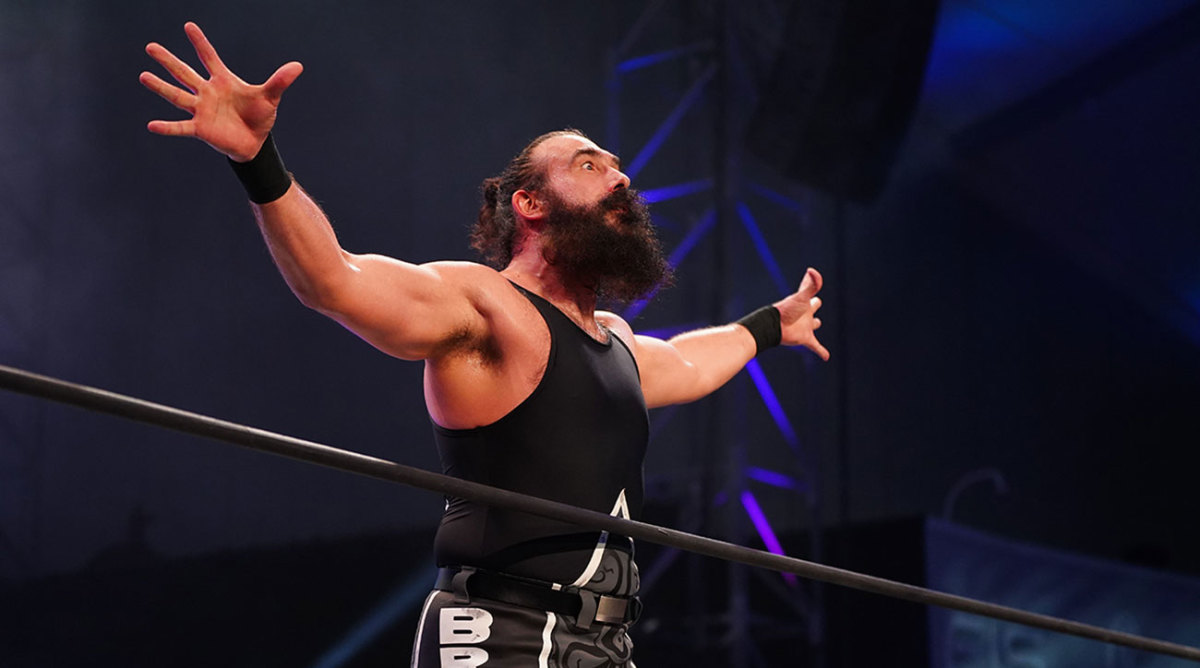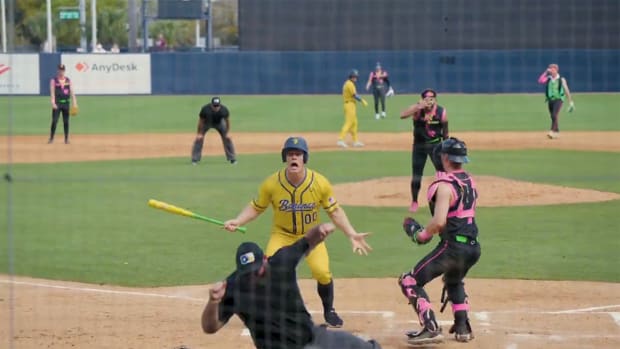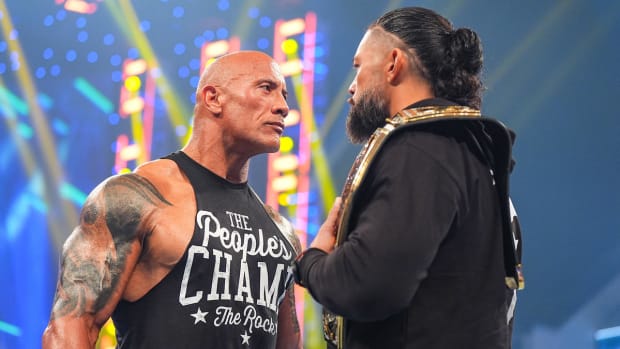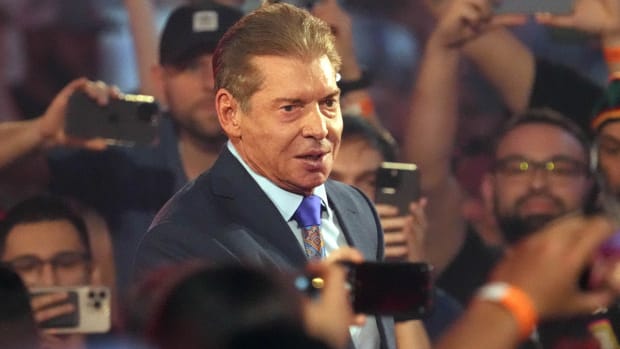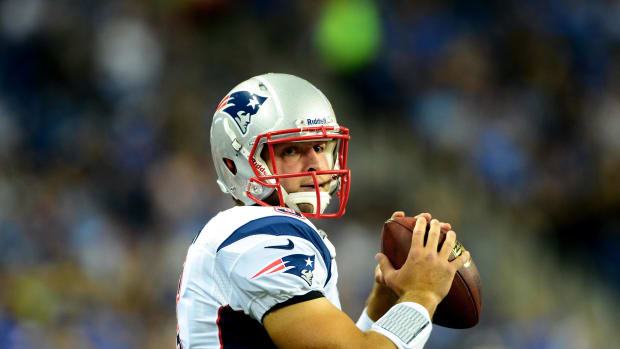Jon Moxley Shares Memories of the Late Brodie Lee
Jon Huber captured people’s attention. Whether he was performing as Brodie Lee or Luke Harper, he accomplished wrestling’s most difficult feat.
Huber made fans believe.
Wrestling’s most skilled performers find a way to suspend disbelief and make people believe in the magic of their work. That is the beauty of pro wrestling. Even more meaningful than raw athletic feats, making someone believe creates a lasting connection.
Huber spent his life harnessing and honing his craft, unrelentingly seeking the right look, style and character. The end result was forging a timeless piece in the pro wrestling realm, though one that, heartbreakingly, will not feature a next chapter.
Late Saturday night when it was announced that Huber—the indestructible, thick-bearded, unstoppable force in wrestling—had died due to a lung-related illness. At the age of only 41, when he was just hitting his prime as both a performer and a parent, Huber's life was cruelly ripped away from him.
“It doesn’t feel real,” says Jon Good, who is best known as AEW star Jon Moxley, on Sunday evening. “It feels like I’m in a very vivid dream and I’m waiting to snap out of it. My brain hasn’t accepted it yet. Right now, I’m completely f------ numb.”
As news of the death circulated on Saturday night, memories of Huber’s work as Brodie Lee in AEW and Luke Harper in WWE immediately came flooding into the minds of those who relished watching him perform. Amid the sadness, people also reflected on the resilience and perseverance that defined Huber’s body of work in pro wrestling, an industry somehow as cutthroat as it is sublime.
Had Huber emerged in pro wrestling in the early 1980s, the mind does not have to wander too far before envisioning a dominant, awe-inspiring run through the territories as a hulking monster before landing in the World Wrestling Federation to battle Hulk Hogan. But the style of pro wrestling has evolved over the decades, presenting an even more difficult landscape for a larger-than-life big man. Yet Huber found a way to forge his own identity, developing a frightening persona, complete with a set of eyes that had the ability to peek into your soul. He built his reputation throughout the indies, working a believably violent style. His work with Moxley in CZW and EVOLVE, as well as with Eddie Kingston in Chikara, particularly resonated. It became evident to those viewing that this big man was a force, one that was willing to hit hard and ensure contact was nothing less than snug.
“The first night we wrestled each other, we shared a hotel room together later that night,” says Moxley. “That was over a decade ago. He was an incredible person. While so many of us would be all hot about some wrestling angle, he would find a way to turn negatives into a positive or an inside joke. He was the exact person you wanted in the locker room. I was so glad to be around him again in AEW.
“And we wrestled so many times. Whether it was on the indies, in The Shield–Wyatt war, six-mans on house shows and European tours, it felt like we were always together. When Tony Khan asked me about Brodie in AEW, I said, ‘Hell yeah, I want that match.’ We could wrestle each other in our sleep. He was so f------ good.”
Moxley also wrestled Huber in his tryout match for WWE.
“We always joked that he’d be a substitute teacher in Rochester if I hadn’t made him look so good, but the truth is he was this can’t-miss, undeniable talent,” says Moxley. “He was an athletic big man that could work circles around everybody.”
Huber needed few words to capture a rare blend of mystery and suspense as part of The Wyatt Family. Beside Bray Wyatt and Erick Rowan, the trio created magic rarely on display in pro wrestling. Though Wyatt was the star, it was the ensemble that completed the act. Their showdowns with John Cena, The Shield, Daniel Bryan, and The New Day still stand out as memorable scenes that captured realism, believability, and fear, which is exceedingly difficult to do in pro wrestling.
There were also glimpses of Huber’s in-ring brilliance as a singles performer in WWE. Despite his tag-team conquests with Rowan, Huber always hungered for a chance to be a solo act. His one singles title run took place six years ago, when he was given just under a month with the Intercontinental Championship. He dropped the belt back to Dolph Ziggler in an extremely underrated ladder match at TLC in 2014, bumping and selling and making Ziggler look like a bona fide star by overcoming this 6’5” force.
A few months later, Huber took part in a multi-man ladder match at WrestleMania 31, his first-ever match at a WrestleMania. He again demonstrated the lengths he was willing to take in order to be viewed as someone the company could build around.
“We wanted to make the highlight reel,” says Moxley. “We figured the only way we could do that was if I nearly killed myself with a death-defying bump. So we devised this spot where he powerbombs me from the ring to the floor through a steel ladder, and that’s f------ sketchy. It’s an extremely dangerous bump, going backward at a high angle.
“It was a gnarly bump. Vince [McMahon] bugged out. He thought I was dead, which meant it was a good f------ bump. And we made the highlight reel. I maintain to this day that I would not have trusted anybody else on the planet with that bump. I put my life in his hands, and I walked away.”
Over the following four years, Huber never found the secret to singles success in WWE. So he took matters into his own hands.
Despite WWE's offering outrageous compensation for his services, Huber took the road less traveled in pro wrestling. He gambled on himself, signing with AEW. The timing, as it turned out, could not have been worse. A pandemic removed fans from live events, exposing wrestling as a different entity without the magical element of a packed crowd inside the venue. Instead of debuting on a Dynamite in his hometown of Rochester, New York, Huber instead revealed himself as “The Exalted One” of The Dark Order on a closed-set Dynamite in March.
Featuring Huber as leader of The Dark Order seemed like a failed proposition, as the group had been unable by that point to connect with the audience at-large. Yet a funny thing happened on the way to The Dark Order’s road to obscurity, as Lee’s presence proved to be the piece necessary to bring the group to life. His humor and edge perfectly suited a group adamantly claiming it was not a cult.
That scene repeated itself after Huber lost a world title match to Moxley at the Double or Nothing pay-per-view in May. Naturally, after losing a world title match, there were concerns that Huber would struggle to find his place on the AEW script moving forward.
Once again, Huber rewrote the script.
Huber finally removed any doubt regarding his value as a singles entity when he bludgeoned Cody Rhodes and claimed possession of the TNT Championship in August. He finally had television segments to wreak havoc in the ring, as well as time to use the microphone as his pulpit. As summer turned to fall, Huber built himself into a champion worth watching. The Dark Order instantly, it seemed, became appointment viewing, which it still remains. That stretch with the TNT Championship served as affirmation to every belief Huber had about himself as a pro wrestler—despite years of doubt and executives telling him that his spot was in the supporting cast, Huber showed he had the chops to be the lead.
“It wasn’t a secret to anyone in the business how good he was,” says Moxley. “But he was always used in a utility role or part of a group. For him to be the centerpiece of a group as a solo act, he proved he was a main-event performer.”
Full of surprises, Huber had so much more to give to pro wrestling. And, more importantly, to his two children and his wife, whom he loved dearly.
“He wasn’t interested in being famous,” says Moxley. “This is a guy you would not see at an afterparty. As soon as he was done with work, he was going home to his family as soon as possible. He was so proud to be a father and a husband. He loved wrestling and he was great at it, but it was his job. He was lucky enough to love his vocation, but his most important role in life was as a father and a husband.”
Multiple layers were all a key part of Huber’s charm. Yes, he had that frightening, Bruiser Brody–like intensity in his work. He also had an endearing sense of humor, an ability to connect with people through a succinct seven words on Twitter, and a skill and passion that few of his peers possess. But once he dropped the TNT Championship back to Rhodes on the October 7 edition of Dynamite, Huber seemed to vanish from AEW programming.
As of now, little information is available about the circumstances surrounding his illness. His passing is a gut-wrenching reminder of the fleeting nature of life. Yet it is also a very loud testimonial to the power of pro wrestling. This industry runs much deeper than just entertainment. It represents a chance to create a piece of work that will endure. Huber made people believe in the magic of his work, capturing the sweetness of an industry that has its fair share of poison.
There will eventually be some solace amid the tears knowing that the work of Brodie Lee will live on, but for now, the pain and grief continues to intensify over the loss of this giant of a man, friend and performer.
“I’m grateful I got to spend so much time with him, from the time we first met on the indies,” says Moxley. “I’ll always picture him with that smile on his face. I still can’t wrap my brain around this. I don’t understand why the best people are the ones taken away so early.”
Justin Barrasso can be reached at JBarrasso@gmail.com. Follow him on Twitter @JustinBarrasso.
